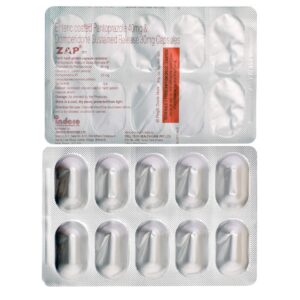DOMPERIDONE + PANTROPRAZOLE
Domperidone: Domperidone is a medication used to relieve symptoms of nausea and vomiting. It belongs to a class of drugs known as dopamine antagonists. It is commonly prescribed for patients who experience gastrointestinal disorders such as gastroparesis, reflux, or functional dyspepsia.
The mechanism of action of Domperidone involves blocking dopamine receptors in the brain and gastrointestinal tract. By doing so, it increases motility in the digestive system, which helps to reduce feelings of nausea and vomiting.
The dosage of Domperidone varies depending on the individual and the condition being treated. For adults, the usual recommended dose is 10 mg, taken orally three to four times a day, before meals and at bedtime. The maximum daily dose should not exceed 30 mg. It is important to follow the instructions provided by the healthcare provider or pharmacist.
While generally considered safe, Domperidone can have potential side effects. Common side effects include headache, dizziness, dry mouth, constipation, and abdominal cramps. Rare, but more serious side effects may occur, such as irregular heartbeats, allergic reactions, or movement disorders such as tremors or muscle stiffness. If any significant side effects are experienced, medical attention should be sought immediately.
It is important to note that Domperidone has been associated with a risk of QT prolongation, which can lead to life-threatening arrhythmias. Due to this risk, Domperidone use has been restricted in some countries and is not available over the counter in the United States. In some regions, it may only be prescribed with special authorization, and it is necessary to weigh the potential risks versus benefits for each patient.
As with any medication, it is recommended to consult a healthcare professional before using Domperidone to ensure it is the appropriate treatment option for your specific condition and to discuss any potential risks or drug interactions.
Pantroprazole: Pantoprazole is a medication commonly used to treat conditions related to excess stomach acid production, such as gastroesophageal reflux disease (GERD), peptic ulcers, and Zollinger-Ellison syndrome. It belongs to a class of drugs known as proton pump inhibitors (PPIs).
The mechanism of action of pantoprazole is by reducing the production of gastric acid in the stomach. It works by selectively inhibiting the enzyme responsible for acid secretion in the parietal cells of the stomach. By doing so, it helps relieve symptoms associated with excessive stomach acid and allows for the healing of existing ulcers.
Pantoprazole is typically taken orally, usually in the form of delayed-release tablets, with or without food. The dose and duration of treatment depend on the specific condition being treated and the individual patient’s response. It is important to follow the prescribed dosage instructions given by the healthcare provider.
As with any medication, pantoprazole may have potential side effects. Some common side effects may include headache, nausea, stomach pain, diarrhea, and dizziness. Rare but serious side effects may include severe allergic reactions, vitamin B12 deficiency, kidney problems, and an increased risk of bone fractures.
It is important to inform a healthcare provider about any existing medical conditions, other medications being taken, and allergies before starting pantoprazole therapy. They can provide further guidance on the appropriate use, dosage, and potential side effects of the drug based on individual circumstances.

